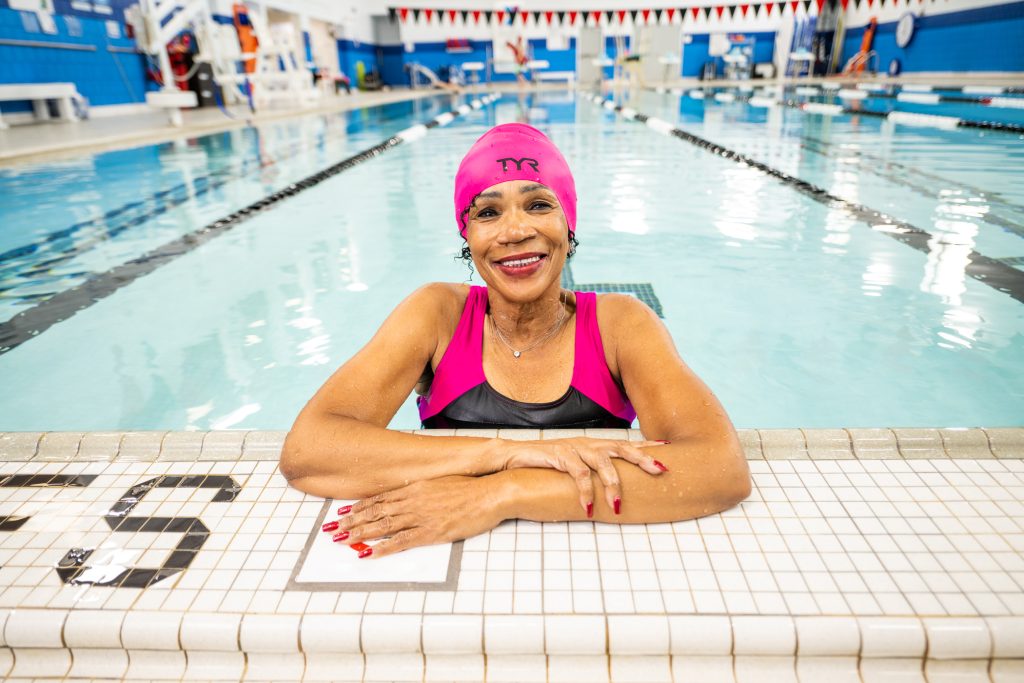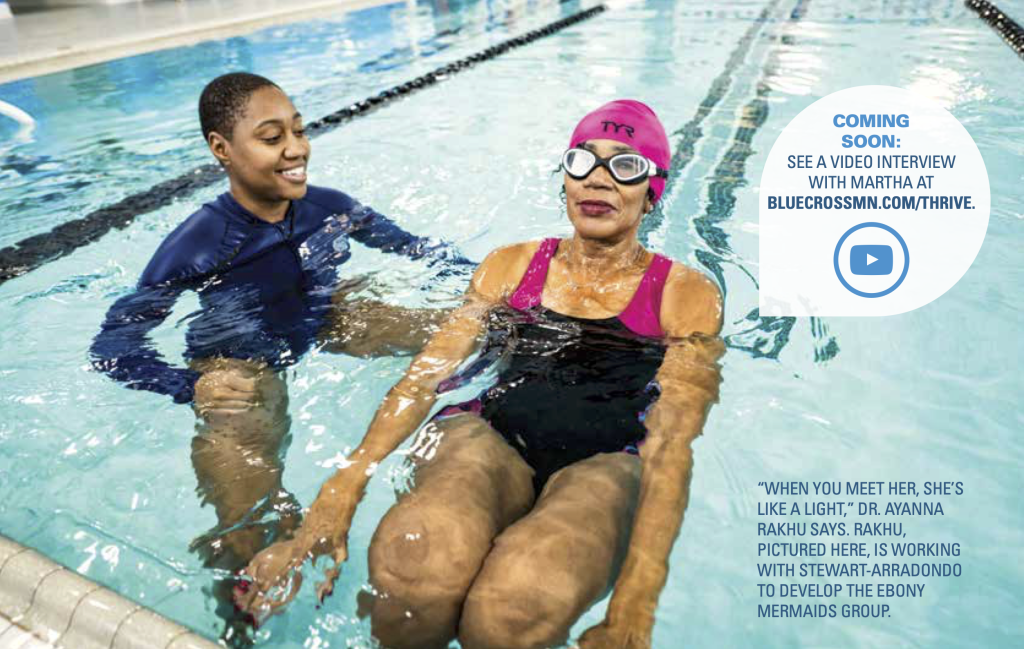FOR MARTHA STEWART-ARRADONDO, it’s never too late to learn something new. The 76-year-old St. Louis Park resident is living proof.She has made physical activity and social engagement lifetime priorities. And she seizes every chance she has to compete, something she didn’t have an opportunity to do through out much of her life. By building groups in activities she’s passionate about, she has also opened the door for others to get involved. Prioritizing all forms of activity — physical, social, mental — is Stewart-Arradondo’s legacy.“I hope to set an example and be a role model for my kids, grandkids, and great-grandkids,” she says.
Driven to overcome
Stewart-Arradondo was born inDes Moines, Iowa, but grew up in Minneapolis. She faced many difficulties in her youth, including living in a series of foster homes until she was an adult. She attributes her motivation to connect and build community with others to her childhood challenges.“Every bad thing you hear about foster homes probably happened to me,“ she says. “And there are some advantages to that. It made me independent, it made me a good judge of character, and, probably, it made me more driven in life.” Like other women her age, Stewart-Arradondo grew up in a time when women’s athletics were limited. Competitive by nature, she was deprived of the opportunity to compete. She has made up for that as an adult.
She has been involved in many activities in her adulthood — softball, racquetball, golf, swimming, and pickleball, to name a few. She doesn’t just play these sports, she gets immersed in them. She’s currently in a pickleball league at Lifetime Fitness and on the board of Minnesota Masters Swimming. She’s also a co-founder of BlackWomen on Course (BWOC), a golf league for Black women, and is working with V3 Sports, a planned fitness and swimming facility in North Minneapolis, to bring Ebony Mermaids, a swim club for Black women, to life.
Her passion for these activities and many others throughout her life have resulted in lasting friendships.“I don’t know many people young or old who are as active, curious and open to new things as Martha,”says longtime friend Ann Eilbracht, who met Stewart-Arradondo playing racquetball about 40 years ago.
Get out there

Staying active as you age can help you live longer. Getting involved in sports like golf or swimming, helps relieve stress, reduce the risk of health issues, and improves your overall well-being.
Healthier, happier
Stewart-Arradondo credits her regular activity, throughout her adulthood, for her strong physical and emotional health. She believes that her athletic and social engagements have helped her avoid experiencing major health issues.“I do have two torn meniscuses,” she says, “and after a certain age they won’t do surgery. Swimming and the occasional cortisone shot take care of my knee pain when it flares up.”
But there is another important reason that she prioritized her physical and social activities throughout her adulthood: “Because I might live longer,” she says.Science agrees. Mental Health America emphasizes the importance of good relationships. People with strong social connections tend to be happier, and more importantly, social and community ties were shown to increase longevity in study participants.
Of course, physical activity has well documented benefits including better cardiovascular health and improved strength and balance.But social activity, whether that is through physical activity or not, has a holistic, positive impact that improves physical health, mental health and brain function.
A 2020 study from the National Academies of Sciences, Engineering and Medicine shows that older adults who report feeling lonely have an increased risk of heart disease and stroke, in addition to mental and cognitive health issues like depression and dementia. Stewart-Arradondo says her secret to staying engaged in her social circle is one small word — yes.“I won’t ski,” she says, “but I’ll do anything else. If a friend calls me up and invites me somewhere, I always say ‘yes.’”
Increasing inclusion
What is most notable about Stewart-Arradondo’s involvement in competitive sports is that she doesn’t just pave the way for her own participation, but she blazes a trail for other Black women to get involved, too. Twenty-five years as a corporate meeting planner helped her to develop the necessary skills to organize people and events — something she still passionately does today through her own company, Stewart-Arradondo Planning Group.
She has been instrumental in creating safe spaces for Black women to participate and compete in sports that have traditionally existed in white spaces, such as golf and swimming. African Americans were long-denied access to golf courses and swimming pools across the U.S. Participants of color are still underrepresented in these sports, something Stewart-Arradondo is trying to change.
When she co-founded BWOC, the vision was to build a community of Black women golfers from all ages and skill levels. She wanted to create a safe space for women of color to learn and practice golf. Currently,BWOC hosts women between the ages of30 and 80, and all members participate at various levels of play.Of course, there are both physical and social benefits of hitting the links. But many of the women joined the golf group because of the potential financial benefits, as well.“We all know that business deals happen on the golf course,” she says. “Many of the women in BWOC are professionals who want to be able to use golf as a way to network.”While swimming may not have the same business benefits as golf, Stewart-Arradondo thinks it’s equally important for every one to learn to swim. Stewart-Arradondo began swimming later in life as a way to maintain her weight. Shortly after she learned how to swim, she joined the Minnesota Masters Swimming and began competing. She also became a certified swim instructor because she was motivated to help adults learn to swim.
“Everyone over 30 who doesn’t swim has their own story,” she says.“ Whether they almost drowned once or were thrown into the water. I am excited to get Ebony Mermaids started because I know there is a need for this kind of group.”Her swim club is currently in the planning stages. She is working together with V3 Sports to build a structured program.
“She just dove in head first and she’s absolutely fearless,” Tom Hodgson, a coach at Minnesota Masters Swimming, says. “When that V3 facility is open, I just seeMartha taking a whole bunch of people by the hand, probably starting with women of color, and getting them involved.”Stewart-Arradondo might be a role model for her family, but she is also an example of what older adults can achieve, and how they can feel, regardless of their age. “Staying active is how I feel healthy and youthful,” she says.“I think staying active should be everyone’s priority, and it’s never too late to start.
Did you know?

Being socially active combats loneliness, and there are several ways for older adults to continue being engaged with their local community. The National Institute on Aging says that volunteering, calling friends and relatives on the phone, and adopting a pet are examples of ways to positively impact your social and emotional health



